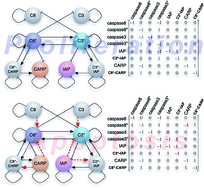Deduction of intracellular sub-systems from a topological description of the network†
Abstract
Non-linear behaviour of biochemical networks, such as

* Corresponding authors
a
Automatic Control - School of Electrical Engineering, Royal Institute of Technology (KTH), Sweden
E-mail:
tn@kth.se
Web: http://www.ee.kht.se/∼tn/
b JST/ERATO SORST Kitano Symbiotic Systems Project, Japan
c School of Fundamental Science and Technology, Keio University, Japan
d School of Medicine, Keio University, Japan
e
EMBL-European Bioinformatics Institute (EBI), UK
E-mail:
noriko.hiroi@ebi.ac.uk
f Graduate School of Medicine and Faculty of Medicine, The University of Tokyo, Japan
g The Systems Biology Institute, Japan
h Sony Computer Science Laboratories, Inc., Japan
Non-linear behaviour of biochemical networks, such as

 Please wait while we load your content...
Something went wrong. Try again?
Please wait while we load your content...
Something went wrong. Try again?
T. E. M. Nordling, N. Hiroi, A. Funahashi and H. Kitano, Mol. BioSyst., 2007, 3, 523 DOI: 10.1039/B702142A
To request permission to reproduce material from this article, please go to the Copyright Clearance Center request page.
If you are an author contributing to an RSC publication, you do not need to request permission provided correct acknowledgement is given.
If you are the author of this article, you do not need to request permission to reproduce figures and diagrams provided correct acknowledgement is given. If you want to reproduce the whole article in a third-party publication (excluding your thesis/dissertation for which permission is not required) please go to the Copyright Clearance Center request page.
Read more about how to correctly acknowledge RSC content.
 Fetching data from CrossRef.
Fetching data from CrossRef.
This may take some time to load.
Loading related content
